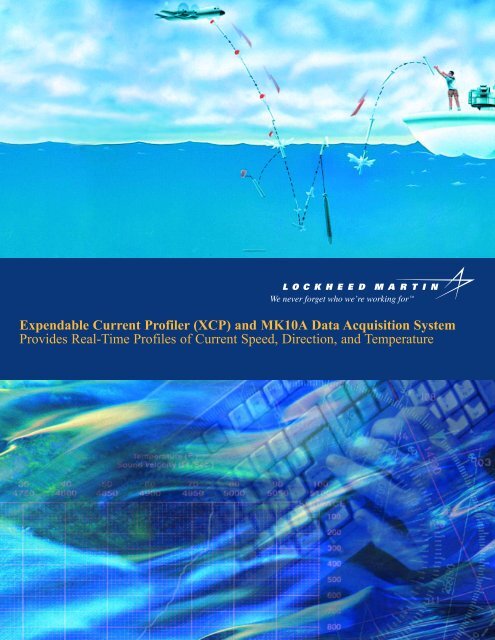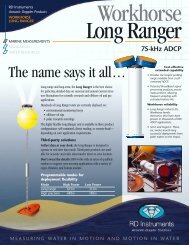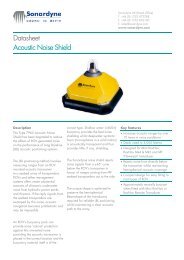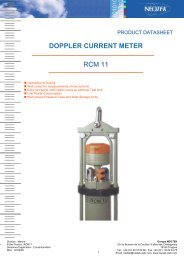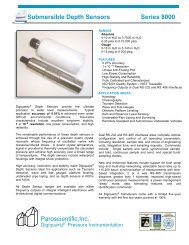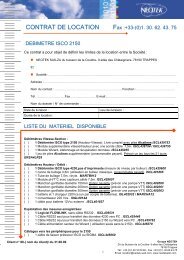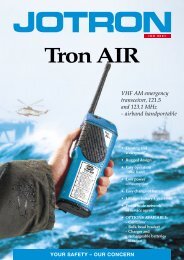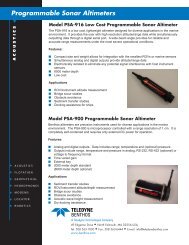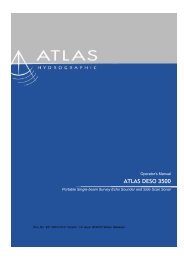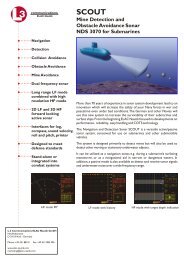Expendable Current Profiler (XCP) and MK10A Data Acquisition ...
Expendable Current Profiler (XCP) and MK10A Data Acquisition ...
Expendable Current Profiler (XCP) and MK10A Data Acquisition ...
Create successful ePaper yourself
Turn your PDF publications into a flip-book with our unique Google optimized e-Paper software.
<strong>Expendable</strong> <strong>Current</strong> <strong>Profiler</strong> (<strong>XCP</strong>) <strong>and</strong> <strong>MK10A</strong> <strong>Data</strong> <strong>Acquisition</strong> System<br />
Provides Real-Time Profiles of <strong>Current</strong> Speed, Direction, <strong>and</strong> Temperature
<strong>Expendable</strong> <strong>Current</strong> <strong>Profiler</strong> (<strong>XCP</strong>)<br />
<strong>and</strong> <strong>MK10A</strong> <strong>Data</strong> <strong>Acquisition</strong> System<br />
Provides real-time profiles of current speed,<br />
direction, <strong>and</strong> temperature to depths of<br />
up to 1500 meters in virtually any<br />
weather conditions.<br />
Lockheed Martin’s <strong>Expendable</strong><br />
<strong>Current</strong> <strong>Profiler</strong> (<strong>XCP</strong>) is the first<br />
expendable which provides real-time<br />
profiles of current speed, direction,<br />
<strong>and</strong> temperature to depths of up to 1500<br />
meters in virtually any weather conditions.<br />
It is ideal for rapidly profiling an<br />
area of interest <strong>and</strong> for complementing<br />
the data obtained by hullmounted <strong>and</strong><br />
moored current measuring systems.<br />
Use of the <strong>XCP</strong> will also<br />
eliminate some of the problems encountered<br />
with traditional current measuring<br />
systems such as the loss of expensive<br />
equipment <strong>and</strong> more importantly, the<br />
inaccuracies caused by ship motion <strong>and</strong><br />
mooring instability. The <strong>XCP</strong> requires<br />
no launcher; it can be easily deployed<br />
over the side of any surface ship by<br />
h<strong>and</strong>. The <strong>XCP</strong> is also available in a<br />
sonobuoy configuration for aircraft<br />
launch at speeds up to 180 knots <strong>and</strong><br />
to altitudes of 2000 feet.<br />
Description<br />
The <strong>XCP</strong> <strong>MK10A</strong> System consists of<br />
the <strong>MK10A</strong> Digital <strong>Data</strong> Interface, a<br />
PC <strong>and</strong> an expendable current profiler.<br />
The <strong>MK10A</strong> has been designed for PC<br />
compatibility with Windows. Up to three<br />
radio receivers, operating on the st<strong>and</strong>ard<br />
frequencies of sonobuoy channels 12, 14,<br />
<strong>and</strong> 16, may be fitted within the <strong>MK10A</strong>.<br />
The <strong>MK10A</strong> is mounted easily in any<br />
19-inch electronics rack.<br />
Operational Sequence<br />
The <strong>XCP</strong> is deployed by h<strong>and</strong> over the<br />
side of any ship. A battery within the<br />
surface buoy activates upon water impact<br />
<strong>and</strong> quickly attains the operating voltage<br />
required to power the buoy electronics.<br />
Power is applied to the RF transmitter<br />
<strong>and</strong> to a timing circuit. The surface buoy<br />
releases the <strong>XCP</strong> probe after a 40 second<br />
delay <strong>and</strong> data collection begins. Ship<br />
operation is not restricted as probe data<br />
is telemetered via a radio frequency (RF)<br />
link to any receiver within line sight of<br />
the <strong>XCP</strong>’s surface buoy. The <strong>MK10A</strong><br />
receives the radio frequency output of<br />
the probe in real time <strong>and</strong> converts the<br />
signal into digital format. The <strong>MK10A</strong><br />
then transfers the digitized <strong>XCP</strong> data<br />
to the PC for further processing. The<br />
digitized data received by the PC is<br />
processed, stored <strong>and</strong> displayed in<br />
tabular or graphic form. Up to eight<br />
parameters may be displayed including<br />
temperature <strong>and</strong> depth. A hard copy of<br />
the data may be obtained later using<br />
printing <strong>and</strong> plotting equipment. After<br />
the probe has completed its descent, the<br />
RF transmitter disables <strong>and</strong> the entire<br />
buoy assembly scuttles, clearing the<br />
radio frequencies for the reception of<br />
additional profiles.<br />
Specifications<br />
©2005<br />
Lockheed Martin Corporation<br />
All Rights Reserved<br />
Lockheed Martin<br />
Maritime Systems & Sensors<br />
Seven Barnabas Road<br />
Marion, MA 02738<br />
An ISO9001:2000 Company<br />
Sea-Air Systems<br />
1(508)748-1160 (x183)<br />
e-mail: james.m.hannon@lmco.com<br />
SEPT2005/NDCR/20050055/Covers:2005<br />
Temp<br />
V (North Velocity)<br />
U (East Velocity)<br />
<strong>XCP</strong> Trace<br />
The color plot on the left displays three of the eight<br />
parameters provided by the <strong>XCP</strong> data acquisition<br />
<strong>and</strong> processing system; north velocity component (V);<br />
<strong>and</strong> temperature (Temp). The five other parameters<br />
include rotational frequency, electric-field baseline,<br />
magnetic compass baseline; area (“tilt” correction);<br />
<strong>and</strong> velocity error. For versatility in analyzing <strong>XCP</strong><br />
data, plot scales may be exp<strong>and</strong>ed or contracted.


